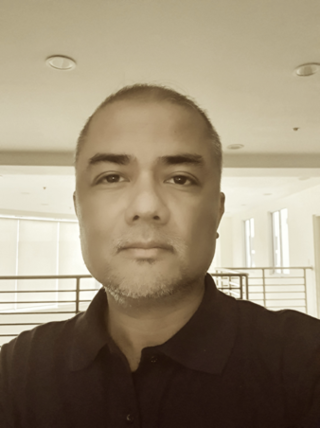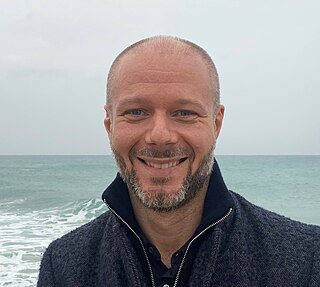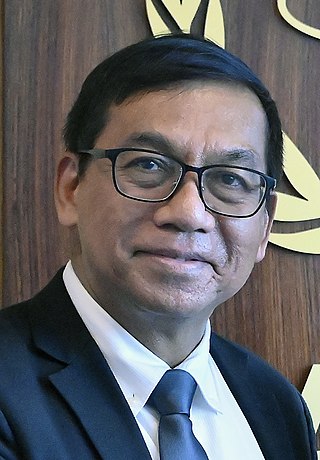Dr. Raymundo Santiago Punongbayan was the former director of the Philippine Institute of Volcanology and Seismology (PHIVOLCS) from 1983 to 2002. Punongbayan became popular after handling two well-known calamities, the 1990 Luzon earthquake and the 1991 Pinatubo eruption. PHIVOLCS is the government agency in charge of conducting volcanic and earthquake monitoring in order to generate data that could be used to predict volcanic eruptions and earthquake occurrences.

On February 17, 2006, a massive rock slide-debris avalanche occurred in the Philippine province of Southern Leyte, causing widespread damage and loss of life. The deadly landslide followed a 10-day period of heavy rain and a minor earthquake. The official death toll was 1,126.

Caesar Aya-ay Saloma is a professor of the National Institute of Physics (NIP) at the University of the Philippines College of Science and a member of the National Academy of Science and Technology.

The Philippine Institute of Volcanology and Seismology is a Philippine national institution dedicated to provide information on the activities of volcanoes, earthquakes, and tsunamis, as well as other specialized information and services primarily for the protection of life and property and in support of economic, productivity, and sustainable development. It is one of the service agencies of the Department of Science and Technology.

Lourdes J. Cruz is a Filipino biochemist whose research has contributed to the understanding of the biochemistry of toxic peptides from the venom of fish-hunting Conus marine snails. Throughout the Philippines, she is known as the Sea Snail Venom Specialist. The characterization of over 50 biologically active peptides from the snail's venom had been made possible, in part, by her studies. Scientific findings regarding the peptides found in snails have applications in diagnostic tools for cancers and the development of drugs for the treatment of neurological disorders. She has also contributed to the development of conotoxins as tools for examining the activity of the human brain. Her contributions to science have earned her several awards and acknowledgements including being named a National Scientist of the Philippines in 2006.

Michael Lim Tan is a Filipino medical anthropologist, veterinarian, and writer who is currently a professor at the University of the Philippines Diliman College of Social Sciences and Philosophy. Tan served as the chancellor of UP Diliman from 2014 to 2020.

Alfredo Villagracia Lagmay was a respected Filipino psychologist and Professor Emeritus of Psychology at the University of the Philippines Diliman. He received his Ph.D. in psychology from Harvard University and trained under the renowned psychologist and founder of the radical behaviorism movement B.F. Skinner.

Edgardo Dizon Gomez, was a Filipino biologist who was conferred the rank of National Scientist of the Philippines in 2014. He was a professor emeritus for marine biology at the University of the Philippines Marine Science Institute.

Diwata-1 also known as PHL-Microsat-1 was a Philippine microsatellite launched to the International Space Station (ISS) on March 23, 2016, and was deployed into orbit from the ISS on April 27, 2016. It was the first Philippine microsatellite and the first satellite built and designed by Filipinos. It was followed by Diwata-2, launched in 2018.

Project NOAH (Nationwide Operational Assessment of Hazard) is the Philippines' primary disaster risk reduction and management program. Managed by the University of the Philippines, it was initially administered by the Department of Science and Technology (DOST) from 2012 to 2017.

Fortunato "Boy" Tanseco de la Peña is a Filipino engineer and professor who served as the Secretary of Science and Technology in the Cabinet of President Rodrigo Duterte from 2016 to 2022. Before he assumed leadership of the Department of Science and Technology (DOST), he was the Undersecretary for Scientific and Technological Services from 2001 to 2014. Except for his brief retirement from 2014 to 2016, he has been with the department since 1982.

Nicola Paula Cayco Curato, also known as "Nicole Curato", is a Filipina sociologist best known for her academic work on deliberative democracy, and her media work providing academic commentary on politics in the Philippines.

The Philippine Scientific Earth Observation Microsatellite (PHL-Microsat) was a satellite program carried by the Department of Science and Technology (DOST) of the Philippines in cooperation with the Tohoku and Hokkaido University of Japan.

The Philippine Genome Center (PGC) is a multi-disciplinary research facility in Quezon City, Metro Manila, Philippines which specializes in genomics.
The Philippine government has commenced a project to develop a locally designed and manufactured Automated Guideway Transit System (AGTS) through its Department of Science and Technology (DOST). Two prototype lines has been set up by the DOST, one within the University of the Philippines Diliman campus and another in Bicutan in Taguig.

Joel Joseph Sacro Marciano Jr. is a Filipino engineer, academic and the first and current Director General of the Philippine Space Agency, a government agency under the Office of the President in charge of the Philippines' national space program.

Giuliano Di Baldassarre is a professor of hydrology at Uppsala University and the Director of the Centre of Natural Hazards and Disaster Science, Sweden. He was awarded the American Geophysical Union Whiterspoon Lecture in 2020 and the European Geosciences Union Plinius Medal in 2021.

Renato Umali Solidum Jr. is a Filipino geologist and government official. Solidum has been Secretary of the Department of Science and Technology (DOST) since August 13, 2022. Before his appointment as Secretary, Solidum served as an Undersecretary for Disaster Risk Reduction-Climate Change Adaptation at DOST and as the Officer-in-Charge of the Philippine Institute of Volcanology and Seismology (PHIVOLCS).

Mudjekeewis Dalisay Santos is a Filipino fisheries scientist and marine biologist at the National Fisheries Research and Development Institute (NFRDI). He was the first Career Scientist to have been conferred the Scientist V rank by the Scientific Career System. In July 2018, he was elected and conferred as an academician member of the National Academy of Science and Technology of the Philippines (NAST-PHL). He is also the president of the Philippine Society in Biochemistry and Molecular Biology since 2022. His fields of interest in fisheries science are genetics, resource assessment, aquatic biodiversity, biotechnology, climate change adaptation, and policy.

















